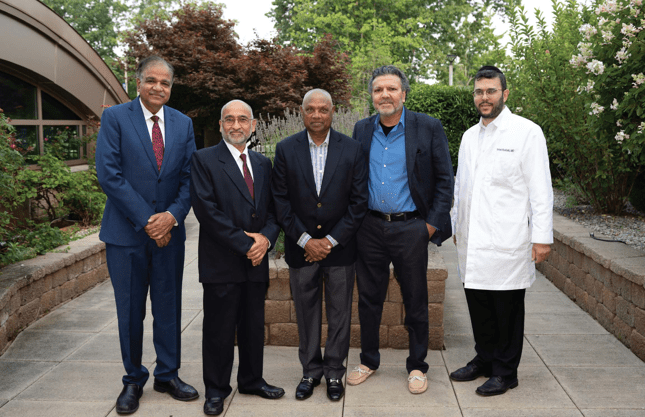
Fractional Flow Reserve Computed Tomography uses artificial intelligence (AI) to evaluate the heart's blood flow and assess blockages to help cardiologists at MMCSC determine treatment.

In movies and TV shows, heart attacks are obvious and dramatic. In real life, they don’t always work that way. One underlying problem is often coronary artery disease (CAD), the most prevalent form of heart disease. With CAD, blockages in arteries of the heart obstruct blood flow. Too little blood supply to the heart muscle can cause symptoms like chest discomfort, shortness of breath or, in extreme heart attacks, sudden death. “CAD can also result in irregular heartbeats of all sorts, called heart arrhythmias, which may result in palpitations or passing out,” says Anil K. Gupta, MD, cardiologist and Chief Medical Officer at Monmouth Medical Center Southern Campus (MMCSC).
A technology available at MMCSC helps clear up uncertainties that can surround heart attacks and related forms of heart trouble. Called Fractional Flow Reserve Computed Tomography (FFR-CT), it evaluates how well blood flows through the arteries of a patient’s heart and determines whether blockages exist, where they are and what impact they have. MMCSC is one of the few hospitals in New Jersey to offer this innovative technology.
A Complementary Test
A variety of tests help determine what’s going on when doctors suspect heart trouble. Typical noninvasive ways of detecting inadequate blood flow include:
- An electrocardiogram (ECG), which measures electrical activity in the heart as it beats.
- An echocardiogram (echo), which uses ultrasound to produce moving images of the heart’s interior.
- A stress test, which evaluates heart function while you increase your heartbeat by exercising or taking a drug, with measurements taken by ECG, echo or with the help of a radioactive dye that’s visible using an imaging machine (nuclear stress test).
- CT scan known as a CCTA (coronary computed tomography angiography), which produces 3-D images that can help doctors rule out significant blockages in the heart’s arteries.
Each test has advantages and limitations. “Depending on the patient, one test may be preferred over another,” Dr. Gupta says.
But prior to FFR-CT technology, the only way physicians could see for certain whether specific coronary arteries were blocked was to do a procedure known as cardiac catheterization and angiogram. In this procedure, a special dye is injected through a long, thin, flexible tube (catheter) that is threaded through an artery, typically in the leg, up to the arteries of the heart. If a blockage is found, the cardiologist can decide whether to correct it during the angiogram—for example, by inserting a small tube (stent) to keep the artery open—or to send the patient for bypass surgery.
“Catheterization with angiogram is the gold standard for diagnosis of coronary artery disease,” Dr. Gupta says. “Unfortunately, catheterization is invasive.”
Adding Insights
Noninvasive FFR-CT uses artificial intelligence to compare images from existing CT scans of a patient’s heart with a database of tens of thousands of other CT images. This helps physicians analyze the likelihood that any specific blockage could cause harm and also provides direction about treatment.
FFR-CT technology creates a personalized three-dimensional image of blood vessels. Color coding indicates the severity of a blockage and shows how it affects blood flow to the heart. This knowledge helps a physician decide whether lifestyle changes, medication, a stent or surgery is the best course of action.
FFR-CT cuts down on false positive results that can occur with other noninvasive tests and also has a low rate of false negatives, making its accuracy unlike that of any other noninvasive cardiovascular test. In some cases, it may spare patients the need for an invasive catheter-based angiogram.
“Two similar-looking blockages don’t always have the same significance,” says Avinash Gupta, MD, Chief of Cardiology at MMCSC. “FFR-CT not only allows us to see anatomically the severity of a blockage, it also shows how much blood flow restriction the blockage is causing and enables us to assess how significant the blockage is. It enhances the accuracy of the diagnosis and makes us more confident that we’re not missing something.”
Who Should Get an FFR-CT Test?FFR-CT technology may have been lifesaving for one of the cardiologists at Monmouth Medical Center Southern Campus (MMCSC). Nachiket Patel, MD, volunteered to test the technology prior to its launch at MMCSC and discovered a 99 percent blockage in one of his arteries that led to cardiac catheterization and stent treatment. “It saved me from a possible heart attack from blockages that I would not have known about prior to the test,” he says. While FFR-CT “is not a screening test,” Dr. Patel says, “it can be invaluable where we see the most utility for it.” When medically appropriate, the scans are covered by most insurance. Insights from an FFR-CT scan can be especially useful in situations such as these:
|
Whoever your heart beats for, our hearts beat for you. To connect with a top cardiovascular specialist at Monmouth Medical Center Southern Campus, call 888-724-7123.